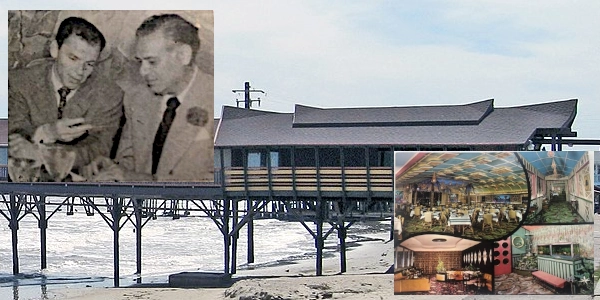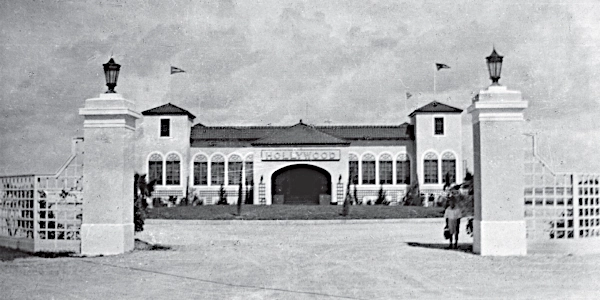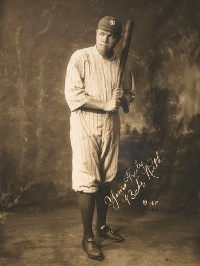Sponsor this page for $100 per year. Your banner or text ad can fill the space above.
Click here to Sponsor the page and how to reserve your ad.
-
Timeline
1919 - Detail
January 16, 1919 - With the state of Nevada becoming the 36th state to ratify the 18th Amendment to the Constitution, prohibition becomes the law of the land. It would remain illegal to consume and sell alcoholic beverages in the United States until passage of the 21st Amendment, repealing the 18th, on December 5, 1933.

Jason Donovan, Author.
As its supporters around the country celebrated the enactment of the 18th amendment, no one saw the cultural tempest that was beginning to build in the distance. And before the hangover of victory could wear off, the storm was upon the country. Prohibition was here, and money was to be made; someone was always thirsty. As a result of alcohol becoming illegal, gangs of bootleggers sprang up to fill the vacuum left by the legal brewers and distillers. These gangs were not just in the large cities. On the contrary, some of the most successful groups were in small cities and towns throughout the country. One of these such groups were the Maceo brothers of Galveston, Texas.
Background of the Maceo Family
In 1901, the Maceo family left Palermo, Sicily, and landed in Leesville, Louisiana. The family consisted of parents Vittorio "Vito" and Angelina Maceo, their children Olivia, Vincenzo, Vincent, and Frank, and the brothers Rosario and Salvatore, who would eventually control an extensive criminal empire.
Rosario "Rose" and Salvatore "Sam" emigrated to Galveston, TX, in 1910, with the rest of the family following in succeeding years. At the time of the brothers' arrival, Galveston was rebuilding after experiencing what is now known as the deadliest natural disaster in United States history: the hurricane of 1900. Before that, The Great Galveston Fire of 1885 made thousands of people homeless.
The Maceo brothers started in Galveston as barbers. They became known for giving their customers and people they did business with bottles of homemade wine. The brothers soon realized from this practice that the real money was in illicit booze. They decided that to further their interests; they should hook up with one of the two main gangs in the area. They soon partnered with the Beach Gang via the gang's co-leader, Dutch Voight.

Expanding the Family Business
This alignment with the Beach Gang does not fully explain the brothers' success. That was the result of a cocktail of factors. Much of Maceo's success was due to the history and geography of Galveston itself. The area now known as Galveston sits on an island situated on a sand barrier located just off the Texas mainland, with its highest point just 20ft (6.1m) above sea level and with a total length of 27 miles (43.5km) and a width of less than 3 miles (5km).Â
Galveston's geography is not the only thing that shaped Galveston's culture that would mold the locals' attitudes towards illicit activities on their island. The history of Galveston is filled with many diverse groups, many of whom were transient. One of the main historical influences that helped shape Galveston's hunger for vice started in the early nineteenth century when pirate and privateer Jean Lafitte. Lafitte used Galveston Island as a hub for smugglers in the Gulf of Mexico. His annual income was measured in millions of dollars in his own time.
With such a rich history of illegal activities, it is no wonder that Galveston's residents, in general, looked the other way when it came to activities of vice on their island. This laissez-faire attitude to vice would serve the Maceo brothers in good stead as their fledgling criminal empire reached stratospheric heights in the early to mid decades of the twentieth century.
To fully understand how the brothers began their empire, one must start with understanding the prohibition era in the United States. The eighteenth amendment of the constitution was ratified on 16 January 1919. The amendment made it illegal to "manufacture, sell or transport intoxicating liquors" within the United States. Even though this amendment was meant to fight the evils of intoxication, an unintended consequence of prohibition was a surge in crime and the rise of the bootleggers and their criminal networks, local and national, that allowed "the water of life," as the Irish call it, to quench the parched throats of the locals and tourist alike.
The Maceo brothers stepped into this melting pot of history, culture, and an influx of fellow immigrants. Starting as barbers who would give their customers complimentary bottles of homemade wine for doing business with them, the brothers quickly realized the obvious: the money was in the wine, not the hair.
The brothers' attitude toward crime is ingrained in them from the long history of the mafia's saturation of Sicilian culture and daily life. This culture equipped the brothers with skills they would use to run and maintain their criminal empire for roughly thirty years. You can take the brothers out of Sicily, but you can not take Sicily out of the brothers.
When the Maceos relocated to Galveston, as mentioned above, they worked as barbers. Rose worked at a shop on Murdich's Bathhouse while Sam worked at the Galvez Hotel. Since the brothers lived in poverty, the illicit markets were the natural doorway to lifting themselves out of poverty. The Maceos are just another case study that proves the point poverty and desperation drive people into the underworld with open arms, where a person's economic security is paramount; violence is always part of the equation. Rose made contact with Galveston's illicit activities while working on the pier. These contacts were the brother's introduction into the Galveston underworld.
While working at the Galvez Hotel, one of Sam's regulars was the co-leader of The Beach Gang named Dutch Voight. It was Dutch Voight who, in 1921, made Rose an offer. Dutch was in a bit of a jam; he had bought a large consignment of alcohol consisting of 1,500 bottles. A load of this size put Dutch on the Bureau of Customs radar, seeing the writing on the wall and knowing it was only a matter of time before he would be caught and brought up on federal charges. To avoid this Dutch needed someone that could not be linked to him but that could be trusted. So he came to Rose and Sam and made him an offer. The offer was simple: store the alcohol in a crawl space under Rose's house. For their cooperation, they would receive $1 per bottle, equal to $23,625.42, based on 2022 inflation calculations. Rose would have to keep the bottles under his house for only three days. Dutch advised Rose that after three days, he would pick up the bottles to distribute to the end user.
Even though Rose was not enthusiastic about the idea, he agreed to Dutch's proposal. This bootlegging was not outside of the brothers' wheelhouse. They had participated in this activity, just not on the order of magnitude that they would in the coming years. They achieved this by hiding bottles of homemade wine in loaves of bread. They did this mainly during the holidays by handing the wine to their barbershop customers. After the agreed upon three days, Dutch arrived, and Sam asked that the payment be invested in future business arrangements with the Beach Gang. Dutch and Quinn, the other co-leader of the Beach Gang, saw that the brothers could be counted on to do the right thing, aka keep their mouths shut. From this moment on, the Beach Gang and the Maceos became partners in the vice rackets, laying the groundwork for Maceo's future dominance of Galveston.
Profitability, Success, Demise
Many factors helped the Maceos reach the top of the Galveston vice rackets. One of these factors, possibly the most crucial factor, is that Galveston was not the only Texas city to have vice rackets, but Galveston was the only city considered, for roughly 30 years from the 20s to the 50s, an open city known as The Free State of Galveston. Part of being an open city is that the local police left the brothers alone. The brothers were also very diplomatic in their approach to the other gangs on the island. There was some violence, but only as a last resort. At this point, it is essential to say that many types of people participated in illegal activities at this time. It could be argued that there were two main types of people: gangsters and businessmen. The Maceos were the latter. The brothers worked well together. “… Sam was the gracious, amiable frontman, while Rose kept everyone in line. Although Rose played a vital role, he usually remained in the shadows of the operations, and his enforcement efforts did not generate a lot of negative publicity." The Maceos knew one thing: for their businesses to be profitable, they had to keep their fellow citizens on their side. This came easy to Sam and Rose, who, by all accounts, genuinely cared for their community. This would be highlighted by the brothers' willingness to help where and when they could. Their generosity was well known, from paying to have the roof replaced on a church in the city to giving loans to townspeople who had fallen on hard times. They were called loans, but Sam was well-known for never asking for the loans to be repaid. Instead, he would ask the person he helped to help someone else. Their fellow Galvestonians saw the other benefits of the Maceos' activities to their community.
One of these benefits was the increased tourist dollars that the brothers' businesses attracted to the city. The main business that the brothers were known for was their clubs. These businesses were not just nightclubs but more akin to the casino resorts that Las Vegas is known for today.Â
Like in Vegas today, the brothers knew people needed to be drawn to their resorts. To this end, the brothers hired a promoter named William Roe: "…William Roe was a brilliant promoter hired by the Maceos to market Galveston as a destination and resort town. Perhaps his most ingenious scheme was the invention of a beachside beauty contest that would eventually become the Miss Universe Pageant, but on a day-to day basis Roe was most known for his persistent relationship with the local press. Of course, the news he released was always positive, praising the merits of the town, its natural beauty and friendliness."
The brothers offered top-shelf entertainment, food, and gambling all under one roof in all iterations of their resorts. Their first establishment was the Chop Suey Cafe on a fishing pier at 21st Street. The cafe opened in 1922 and was known for its oriental decor. This location was remodeled in 1926 and would be re-branded as Maceo's Grotto. Their next resort was located at 61st St. and Avenue S and cost $50,000 (roughly $884,000 in 2024). The Hollywood Dinner Club was "sold out a week before the grand opening and was said to be the first club in the United States with air conditioning." Also, according to the Galveston Daily News, Sam spent $30,000 (roughly $530,000 in 2024) on a deal with Thomas Goggan and Brother Piano Company, one of the best-known piano companies in Texas, to provide the equipment and expertise to outfit the brother's many establishments throughout Galveston so that the world-famous entertainment acts at the Hollywood Dinner Club could be broadcast not to just these businesses but on the local radio station three nights a week as well. Thus providing the Galveston area with what some sources say was the first remote radio broadcast. Even though the Hollywood Dinner Club was hugely popular, the best was yet to come.
It was 1932, and the Maceos opened another club named the Sui Jen cafe, located at the end of a 200-foot pier. It was "… best known for its Oriental name and decorations." The Sui Jen Cafe would last until the Pearl Harbor attack in 1941, which caused Sam to order a complete redesign so that there would be no association with Japanese culture. This would bring forth the brothers' crown jewel of their many resorts. The brother's evolution as resort developers would reach its zenith with the opening of the famous Balinese Room. This resort was designed by a man named Virgil Quadrie. He designed the resort with a South Pacific theme. The decor was impressive for its time; the design "… included a large aquarium that took up one wall of a lounge, palm trees, lights, a bandstand, and an elegant dining room." Everything that went into the Balinese Room was the best, from its design to its staff, from the materials to the entertainment.
By the time the Balinese Room was at its height, the end of an era was slowly, quietly drawing to a close. This piece has so far focused on the entertainment empire the Maceo had built up on the island, but the Maceos were, all the while, still in the rackets. Even though local officials disregarded what the brothers were doing, the state of Texas was a different matter altogether. The state of Texas and the legendary Texas Rangers would consistently raid and investigate, but the brothers stayed one step ahead. Time was not on the brother's side, though. Texans' attitudes towards the rackets had changed, and Galveston was, basically, the last bastion for vice in the state of Texas.
The brothers were very careful to keep themselves insulated from the criminality that was going on in their name; this was very effective. Sam would be brought up on federal narcotics charges, being arrested on 6 October 1937. On 24 January 1938, a federal court ordered Sam and twelve others to be taken into custody pending extradition to New York City, where the trial would take place. Sam's lawyers, in the meantime, filed a writ of habeas corpus. Even though Sam's lawyers would continue the appeals process until The Fifth Circuit Court Of Appeals in New Orleans upheld the original decision, Sam was remanded to the federal marshals' custody until his extradition, then known as removable. After a long, drawn-out legal battle, Sam was finally sent to the Galveston County Jail, where he would stay until being sent to New York in August to stand trial. Sam's trial would not start in November as scheduled but would be placed on hold as the number of people indicted would swell from 88 to 103. In February of 1939, Sam was released on a $10,000 bond. The authors of "Galveston's Maceo Family Empire" go on to state that while Sam was out on bond … "Then assistant United States attorney Joseph Martin announced that he was unsure when the Maceo trial would begin. According to Martin, the trial would remain pending "until after the United States Circuit Court of Appeals has acted upon appeals of co-defendants in the case who were tried last fall." Of the eighty-eight persons originally indicted, forty-five went to trial. Of those who went to trial, forty-two were convicted.
A San Antonio newspaper reported that "two were appealing their convictions with arguments based on the defense claim of technical weaknesses in the indictment. "The decision in these appeals was important in determining if Maceo would be brought to court on the original indictment or if a new indictment would be filed." These charges would continue to hang over Sam for years. In 1940, the case was taken off the court's calendar without clear indication if the trial would ever come. Clarity came on 22 September 1942. Sam's attorneys pushed for a dismissal. They supported their petition by pointing out inconsistencies in the government's star witnesses testimony. First, there was an undercover federal narcotics agent named Clapper. Clapper was the one "who originally identified Sam as being involved." Clapper caused himself problems when he “… refused to provide details about what Maceo was doing when he was initially identified. He argued that the information was provided before a grand jury in New York and that he was under oath not to divulge that testimony." That information was never released in newspapers, even after the case resumed in 1942. However, the agent was able to testify about what he witnessed when he presented himself as an interested customer in Galveston.
Clapper would go on to testify that he met a sex worker named Katherine Philips in the red light district in Galveston. Clapper would continue "… Clapper stated he had met a sailor in Galveston in the summer of 1937. Soon after their meeting, the sailor accompanied Clapper to a house in Galveston's red-light district. Clapper then described his encounter with Katherine Phillips. He explained that he told her he was interested in purchasing an ounce of heroin, and he assured Phillips that he would be back for more if he were satisfied with the product. Therefore, Phillips sold some heroin to him that initial evening. When Clapper returned later and informed her he would like to purchase a larger quantity, Phillips responded by saying she "represented the biggest drug syndicate in New York." Philips would go on to "…set Clapper up with her New York connections, and soon after, Clapper met with "an Italian named 'Frank,” who offered to deliver heroin anywhere in whatever quantities wanted. Shortly after meeting this connection, Clapper had twenty-five ounces of heroin delivered to Waco, Texas.
As for Philips's testimony, Sam's lawyers pointed out that when Phillips stated in effect that Sam Maceo was a continual client, it was "…inaccurate.” Sam's lawyers also pointed out “... Phillips had previously testified she did not know Maceo. In a 1938 case, the defense claimed Phillips had testified that she operated her own drug business. In the previous case, when asked whether or not she knew Maceo, Phillips had declared, "I never knew him enough to recognize him until we were arrested. I knew him on the street, but not otherwise." In the end the court upheld Phillips's right not to answer questions related to her earlier testimony for fear of self-incrimination." The lawyers had done their job when, a few weeks later, it was reported that the jury could not come to a verdict. As a result, Sam would be acquitted of all charges. Sam was reported to have repeated what may arguably have become his mantra throughout his trial "… I'm no angel but dealing in narcotics is just as foreign to me as it is to you.” Murky waters still leave Sam's participation in drugs up in the air.
As mentioned above, 1941 and the Balinese Rooms' success marked the unknown at the time, the slow beginning of the end. The final act for the brothers' involvement in the family came on 16 April 1951, when Sam died. The sadness continued for the Maceo family in 1954 when Rose would succumb.Â
The brother's operation would continue under the leadership of their chosen successors, nephews Anthony J. and Victor J. Fertitta. These brothers lacked many attributes their uncles had mastered over the years. The people of Galveston did not well like the Fertitta brothers. An allegation that came out was that they allegedly skimmed from their gambling operations, which is definitely not good for business. Another factor was that in a post-World War II world, people's attitudes had changed toward vice in Galveston. This change in mentality brought with it more law enforcement scrutiny. The Fertittas did themselves no favors. A case in point was when Anthony heard that some photographers from Time Magazine were in town to investigate Galvestons continuing reputation as an open city. The incident is best described by, once again, the authors of "Galveston's Maceo Family Empire" when they state "… the two men were seen photographing the Turf Athletic Club. When Anthony Fertitta was notified, he, along with a few associates, chased the photographers back to the Galvez Hotel, where Fertitta hit Suydam in the face.” The incident earned the Fertittas significant attention, mainly from non-Galvestonians. Time magazine ran the article, as intended. Two pages of photos were published, revealing prostitution houses still in operation, as well as gambling locations. The article even provided a picture of Suydam's face after being hit by Fertitta at the Galvez Hotel.
Ultimately, it may be best not to view the Maceo brothers as just mere criminals but as ambitious businessmen who came to this country and found a way to achieve the American dream on their terms. They were men who were a product of their environment and cared for the community around them. It is said that a part of the Maceo's success was that, unlike their immediate successors, Sam and Rose had personalities that completed each other. Although Rose played a vital role, he usually remained in the shadows of the operations, and his enforcement efforts did not generate publicity. This is a rule that their nephews should have adhered to.
Although the original famed Balinese Room is no longer standing, washed away by Hurricane Ike, there is a new incarnation. But is was just the original Balinese Room and the history of control over the island rackets that defines the Maceo name. There is still a Maceo presence in Galveston, although their business is all above board this time. According to eyewitness News 13 out of Houston, the Maceo Spice and Import Company is a 75-year-old business that is now owned and operated by third-generation Maceos. Thus, one of Sam's traits lives on through his descendants: take care of your community, and they will take care of you.
The Maceo brothers were just one of the examples of how the prohibition amendment was an absolute failure. They may have been the kingpins of abusing the amendment in Galveston, but there were many others in every city in the United States, from New York to Los Angeles. And although the amendment was overturned on December 5, 1933 with passage of the 21st Amendment, its tenants remained for several decades afterward.
Photo above: Montage: Background, Balinese Club, 2006, Laura Scudder, Nv8200p. Wikipedia Commons CC 3.0. Left: Frank Sinatra and Sam Mateo, 1950. Courtesy Rosenberg Library. Right: Postcard of the Interior of the Balinese Club. Courtesy Rosenberg Library. Photo below: Maceo Brothers Hollywood Dinner Club, Source Unknown. Info source, including quotations: News 13 Houston Video; Fountian, Kimber, “The Maceos & The Free State Of Galveston” Ebook;
Fountian, Kimber, “Galveston’s Red Light District: A History Of The Line” Ebook; T. Nicole Boatman, “Galveston’s Maceo Family Empire” Ebook;Rosenberg Library Museum “The Balinese Room”; and the Galveston Island Guide.





